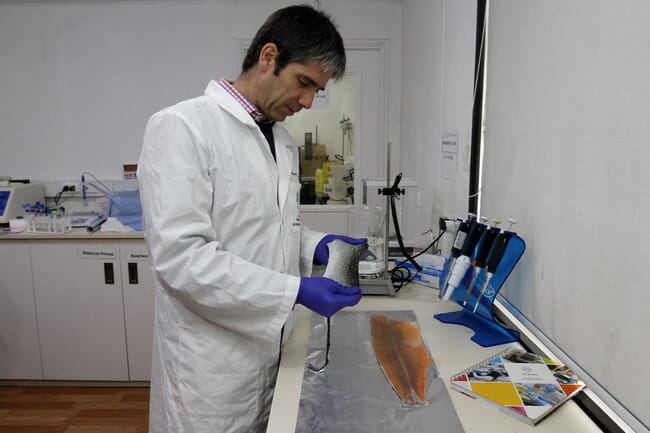Researchers from Universidad de Los Andes are working in cooperation with specialists from the Harvard Stem Cell Institute (HSCI) to develop and produce human tissues using salmon skin gelatin as backing material.
According to the Director of the Technology Transfer Office at the Innovation Department of Universidad de Los Andes, Anil Sadarangani, their work with salmon skin gelatin started several years ago, when the university’s medical school used this by-product as a coating intended to extend fresh salmon shelf-life by up to 30%.
After this venture, the university spin-out Cells for Cells (C4C) came up with the idea of using this gelatin, with a different formulation, in 3D bioprinters.

© Universidad de los Andes
“Those proofs of concept made to date are very good. We have started a collaboration of the most prestigious center of stem cells, HSCI, to collaborate with us in the manufacture of a human organ, which in this case would be the skin at first, which is easier to produce than a kidney or a liver, for example,” Sadarangani explains.
Now they are exploring the possibility of other fish species and by-products, such as bones, heads, scales and tails. “This approach is still at the research stage, since we have to check if the rheological properties are compatible with 3D printing,” Sadarangani adds.
Why salmon?
Most human tissue replacements made from other animals are commonly derived from bovine, porcine, ovine or equine sources. However, this project is centered on fish tissues, using the gelatin from Chilean farmed salmon as the main raw material.

© Universidad de los Andes, Chile.
Sadarangani explains that this decision was made because, as it comes from a cold-water fish, it has an amino acid profile different from that of gelatin from mammals.
“In fact,” says Sadrangani, “there lies its advantage. Currently, in 3D printing, pork or sheep gelatin is used, but the composition of the salmon gelatin allows it to flow at room temperature and not to clog, for instance, the heads of the printer. Besides, the modification of salmon gelatin is quite easy to customize, according to the requirement of the printer.”
Indeed, the research team has conducted trials comparing salmon skin gelatin with the current gold standards of the industry, which are pork and sheep gelatin.
“We have shown that this gelatin is equal or even better in terms of rheological properties (ie the physicochemical properties required by the material). In addition, it generates less immunogenicity – in other words it has a much lower rejection rate by other organisms,” Sadarangani explains.
“When injecting a non-human gelatin into a human, it is usual for a rejection to occur. However, our preclinical experiments – which compared injections of porcine, ovine and salmon gelatin – showed that the latter was least frequently rejected, which is a great advantage if we are considering producing organs with this biomaterial, or with this bio-ink,” he continues.
Printed skin
The scientific principle behind the concept is based on printers like those that print in 3D using plastic polymers.
“The only thing that changes is the cartridge, which will be filled with our salmon skin gelatin,” explains Sadarangani. “This is the great challenge of the biomedical industry: printers are easy to assemble, and there is software and hardware available, but we don’t yet have a material compatible with cells which also complies with the properties needed for printing at the required resolution. The human skin is not a very easy organ to replicate, because it is made up of a huge mosaic of cells. Currently, there is a printing technology called inkjet that facilitates or allows this complexity of the system”.
Once the feasibility of this biomaterial is tested, the possibility of printing other organs, such as kidneys and livers, will be evaluated.
Meanwhile, they expect to produce the first validated and functional prototype of human skin tissue using salmon skin gelatin as backing material by November this year, as a result of their collaborative work with HSCI.


